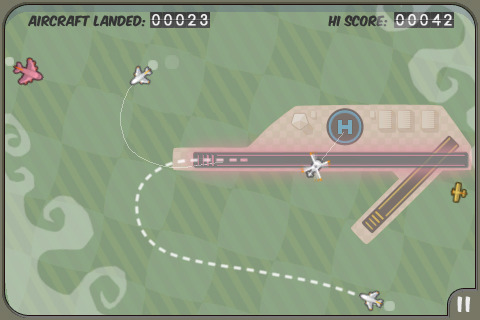As Henry Ford understood, breaking down any job to its component parts makes performing that task as quick and efficient as possible.
Great for business, but it wasn't so good for the personal happiness of his workers. How the focus of employment has changed over the past ninety years.
Thankfully, when it comes to iPhone games the focus is to maximise the juice and minimise the pips - something Mew Zealand developer PikPok has been regularly doing with its
Flick Kick series, which to-date has covered rugby and Australian football.
So with the World Cup in full flow, it's time for non-American football to take to the Flick stage; hence the release of
Flick Kick Football.
Kick-off
The gameplay is simplicity itself: a ball is placed at various distances and angles from the goal, with various configurations of static defenders and a static or dynamic goalkeeper blocking the shot.
You flick the ball to kick. The longer the flick up the screen, the higher the ball travels, providing you with the opportunity to lop defenders. Alternately, flick a curve to bend it like Beckham.
Sounds too basic, perhaps, but the mechanic of gaining bonuses when you hit for the corners of the goal ensures there's a risk and reward balance within your control.
In terms of the main one-miss-and-it's-over Arcade mode, these bonuses enables you to build up up to three additional lives. In terms of the two-minute countdown Time Attack mode, each gives you a three-second bonus for each goal corner gained.
There's also the burning ball bonus. Generated by gaining three goals in a row in Time Attack and a set points during Arcade, this enables your ball to travel through any defender. If you don't use it, it rolls over to your next attempt.
Combined with a Practice mode that lets you play without ceasing for as long as you want,
FlickKick Football is a well defined, if limited experience.
Flicking good
The real reason it works well is the flick control.
It's very simple to pick up, but the curved shots, which are the skill focus, take time to get use to. It's unclear if this level of sensitivity was planned or not, but it makes the game more interesting in the Arcade mode, as does the seeming over propensity of your shots to hit the post.
Probably such perceptions are more in the eye of the beholden kicker than from the developer, and really that's what
Flick Kick Football is all about.
It's a cheap, vaguely World Cup tie-in that you'll find yourself playing in bursts usually measured in minutes, but sometimes unexpectedly in hours. Flicking throwaway fun in other words.
As Henry Ford understood, breaking down any job to its component parts makes performing that task as quick and efficient as possible.
Great for business, but it wasn't so good for the personal happiness of his workers. How the focus of employment has changed over the past ninety years.
Thankfully, when it comes to iPhone games the focus is to maximise the juice and minimise the pips - something Mew Zealand developer PikPok has been regularly doing with its
Flick Kick series, which to-date has covered rugby and Australian football.
So with the World Cup in full flow, it's time for non-American football to take to the Flick stage; hence the release of
Flick Kick Football.
Kick-off
The gameplay is simplicity itself: a ball is placed at various distances and angles from the goal, with various configurations of static defenders and a static or dynamic goalkeeper blocking the shot.
You flick the ball to kick. The longer the flick up the screen, the higher the ball travels, providing you with the opportunity to lop defenders. Alternately, flick a curve to bend it like Beckham.
Sounds too basic, perhaps, but the mechanic of gaining bonuses when you hit for the corners of the goal ensures there's a risk and reward balance within your control.
In terms of the main one-miss-and-it's-over Arcade mode, these bonuses enables you to build up up to three additional lives. In terms of the two-minute countdown Time Attack mode, each gives you a three-second bonus for each goal corner gained.
There's also the burning ball bonus. Generated by gaining three goals in a row in Time Attack and a set points during Arcade, this enables your ball to travel through any defender. If you don't use it, it rolls over to your next attempt.
Combined with a Practice mode that lets you play without ceasing for as long as you want,
FlickKick Football is a well defined, if limited experience.
Flicking good
The real reason it works well is the flick control.
It's very simple to pick up, but the curved shots, which are the skill focus, take time to get use to. It's unclear if this level of sensitivity was planned or not, but it makes the game more interesting in the Arcade mode, as does the seeming over propensity of your shots to hit the post.
Probably such perceptions are more in the eye of the beholden kicker than from the developer, and really that's what
Flick Kick Football is all about.
It's a cheap, vaguely World Cup tie-in that you'll find yourself playing in bursts usually measured in minutes, but sometimes unexpectedly in hours. Flicking throwaway fun in other words.


